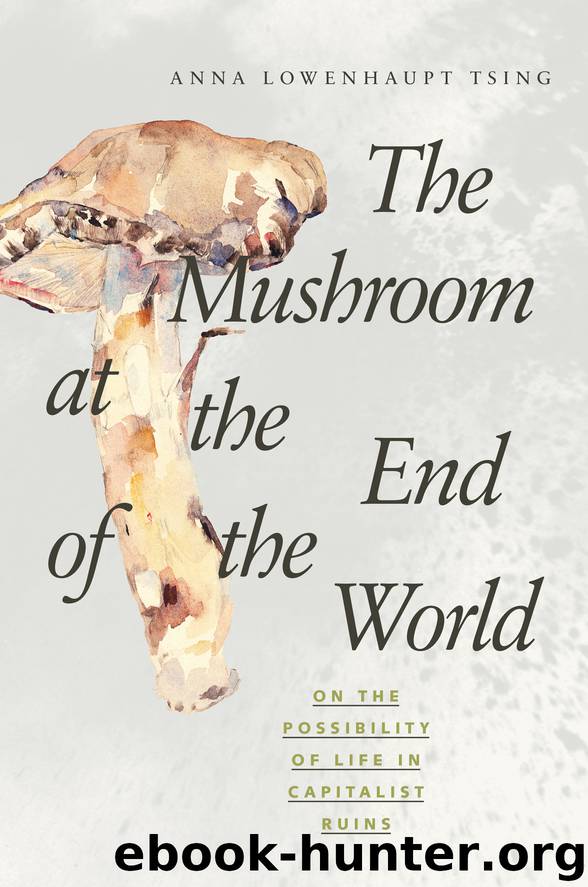The Mushroom at the End of the World by Anna Lowenhaupt Tsing

Author:Anna Lowenhaupt Tsing
Language: eng
Format: epub
Publisher: Princeton University Press
Published: 2015-06-15T16:00:00+00:00
In Japan, one place to begin is not with humans but with the Grey-faced Buzzard (Butastur indicus), a lover of satoyama. These buzzards are migratory, mating in Siberia, then coming to Japan for the spring and summer to raise their young before flying off to Southeast Asia. Male buzzards feed nesting females during egg incubation. They sit atop pine trees, surveying the landscape, looking for reptiles, amphibians, and insects. In May, paddy fields are flooded, and the buzzards look for frogs. When grown rice blocks hunting, the buzzards look into the peasant woodlands for insects. One study found that male buzzards are unwilling to sit on a given tree for more than fourteen minutes if they spot no food.5 The peasant landscape must be laid out as a larder, with frogs and insects appropriately arrayed, for these birds to thrive.
Grey-faced Buzzards have adapted their migration patterns to the Japanese peasant landscape. Meanwhile, all their foods are equally dependent on this disturbance regime. Without maintenance of the irrigation system, the frog population declines.6 And so many insects have evolved just to live with peasant trees! Konara oak (Quercus serrata) has at least eighty-five specialist butterflies that depend on it as food. One colorful butterfly, Sasakia charonda, requires the sap of young oaks—kept young by peasant coppicing; when coppicing is not maintained, the oaks grow old, and the butterfly declines.7
How is it that the ecological relations of peasant forests have come to be the subject of so much research—especially now that Japan’s woodlands have been largely abandoned, as fossil fuels have replaced firewood and as the younger generation has moved to the city? Some researchers are clear: future sustainability is best modeled with the help of nostalgia. At least that was the view of Professor K, an environmental economist in Kyoto.
Professor K told me he had become an economist because he thought he could help poor people. But ten years into a successful career, he realized his research was helping no one. Worse yet, he saw the glazed eyes of his students. He spoke to them and knew it wasn’t just his lectures; his students too had lost touch with questions that mattered. Professor K reconsidered his life trajectory. He remembered his visits as a boy to his grandparents’ village: how alive he felt as he explored the countryside! That landscape sustained people rather than sapping their strength. So he turned his professional work toward restoring Japan’s peasant landscape. He argued and pushed until his university obtained access to an area of abandoned fields and forests, and he took his students there, not just to look but also to study the skills of peasant life. Together, they learned: they re-cleared the irrigation channels, planted rice, opened up the forests, built a kiln to make charcoal, and found their way into taking care of the forest with the eyes and ears of peasants. How enthusiastic his seminars were now!
He showed me the overgrown, abandoned forest that still crowded around their reclaimed fields. There was so much work to do to make a sustainable peasant forest emerge from the tangled brush.
Download
This site does not store any files on its server. We only index and link to content provided by other sites. Please contact the content providers to delete copyright contents if any and email us, we'll remove relevant links or contents immediately.
Craft Beer for the Homebrewer by Michael Agnew(18141)
Marijuana Grower's Handbook by Ed Rosenthal(3623)
Barkskins by Annie Proulx(3313)
Project Animal Farm: An Accidental Journey into the Secret World of Farming and the Truth About Our Food by Sonia Faruqi(3178)
The Plant Messiah by Carlos Magdalena(2883)
Red Famine: Stalin's War on Ukraine by Anne Applebaum(2873)
0041152001443424520 .pdf by Unknown(2784)
Organic Mushroom Farming and Mycoremediation by Tradd Cotter(2628)
In the Woods by Tana French(2533)
Beer is proof God loves us by Charles W. Bamforth(2371)
7-14 Days by Noah Waters(2361)
Reservoir 13 by Jon McGregor(2242)
Borders by unknow(2229)
Meathooked by Marta Zaraska(2220)
The Art of Making Gelato by Morgan Morano(2216)
Birds, Beasts and Relatives by Gerald Durrell(2176)
Between Two Fires by Christopher Buehlman(2164)
The 7 Habits of Highly Effective People: Powerful Lessons in Personal Change (25th Anniversary Edition) by Covey Stephen R(2139)
The Lean Farm Guide to Growing Vegetables: More In-Depth Lean Techniques for Efficient Organic Production by Ben Hartman(2096)
